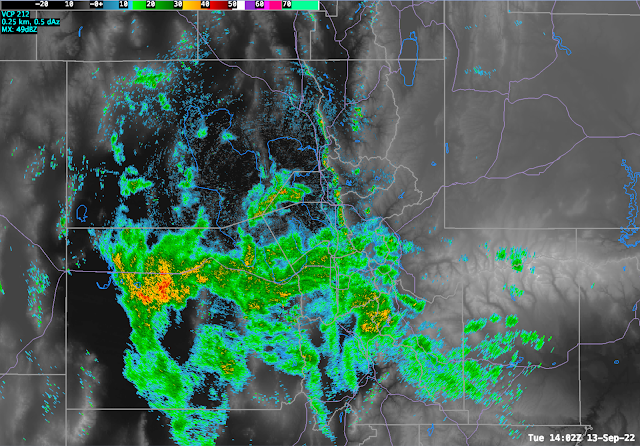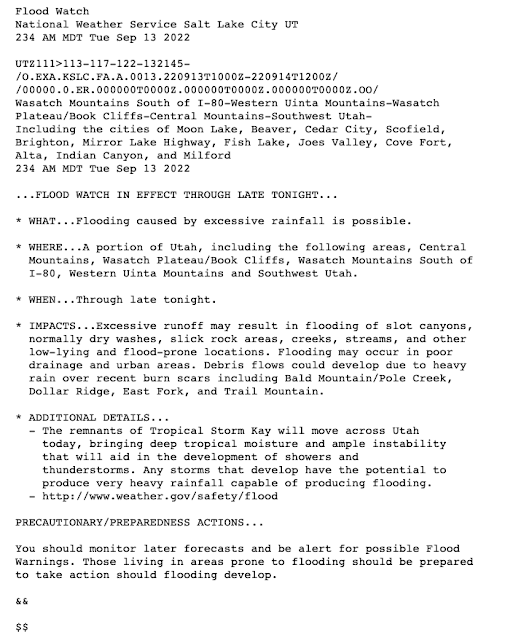I woke up this morning to the smell of rain, or what is known as petrichor. The UK met office has a nice web page explaining the origins of the word and what causes the smell. It says,
"Raindrops landing on dusty or clay soils trap tiny air bubbles on the surface which then shoot upward — as in a glass of Champagne — and burst out of the drop throwing aerosols of scent into the air where they are then distributed by the wind."
Radar imagery at 1402 UTC (8:02 AM MDT) showed showers over portions of northern Utah, some likely heavy, especially in the West Desert.
I'm quite glad to see this as although we had an active monsoon for part of the summer, the last couple of weeks have been hot and bone dry. On the other hand, there are concerns about flooding produced by heavier downpours.
The HRRR suggests that in the Salt Lake Valley we may see more isolated to scattered showers for a time today before things pick up again in the afternoon. We'll see if that plays out. Below is the forecast for 2100 UTC (3 PM MDT) this afternoon when the next area of heavier precipitation with embedded cells is moving north-northeastward through the Salt Lake Valley.
Although we can't count on the details of a forecast like this verifying given the chaotic nature of convective showers and thunderstorms, keep an eye to the sky today as there's a pretty good chance you're going to see something. The NWS has issued a flood watch for some areas of northern Utah, which I've reposted below.



Thank you for petrichor. I too smelled rain before dawn and am delighted to learn this new thing that rain's scent is petrichor.
ReplyDeleteLearn something new every day especially by reading Wasatch Weather Weenies.
As I say and will continue to say, your summer (technically not-winter) blogging is the best.
What does petrichor smell like?
ReplyDeletePetrichor is the smell of rain. The word comes from the Greek words 'petra', meaning stone, and 'ichor', which in Greek mythology refers to the golden fluid that flows in the veins of the immortals.
https://www.metoffice.gov.uk/weather/learn-about/weather/types-of-weather/rain/petrichor
I'm liking the 18 hr HRRR, do you have anything to add to your previous post where you discussed the HRRR in broad concept and the difference between the 48 hour and 18 hour.
ReplyDeleteWasatch Front 18hr total precip seems to be the most informative for our current weather. You agree or is there something better as a simple overview. Time-height is always fun but subtle when what you want to know is how much will it rain where I am at.
Run 2022091520 has 0.96 inches at the airport and 0.51 inches in Sandy by Fri Sep 16 z1400.
September autumn is such a pleasant time of year.
There is no difference between the 18 and 48 hour HRRR. The HRRR is run to 18 hours every hour, and every six hours it is run to 48 hours. If you were to look at the 18-hr HRRR precip at forecast hour 18 and compare it to the 48-hr HRRR at forecast hr 18, they should match. The only reason I have split them in two is that my programming skills presented me from figuring out how to code up weather.utah.edu to deal with models with varying forecast projections.
DeleteI have adding HRRR soundings and time height sections on my to do list, but don't hold your breath. It could be a long time.